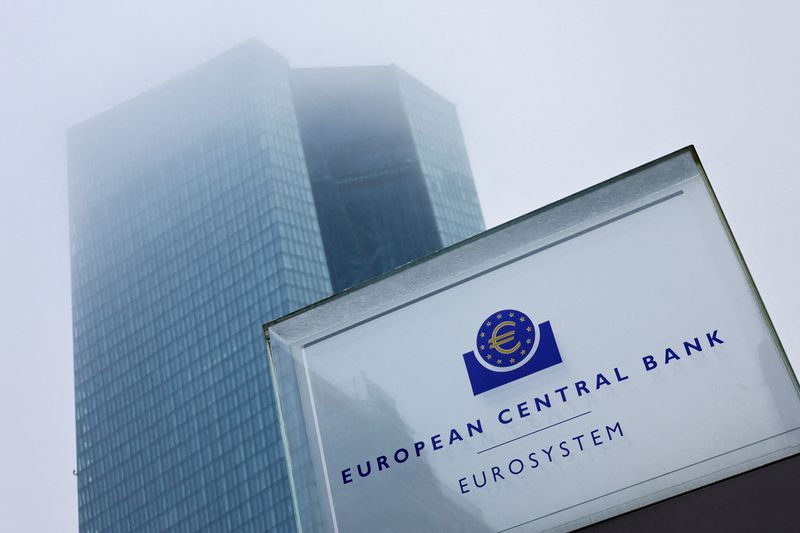By Mike Dolan
LONDON (Reuters) - While there has been a lot of talk about the West's strategic decoupling from China's sputtering economy, Europe's direct trade links with Beijing have actually been deepening.
This difference may help to explain some of the divergence in monetary easing between the Federal Reserve and the European Central Bank. The latter is expected to deliver a second interest rate cut before the Fed even gets going next month and will likely move a third time in October.
If China's economy keeps stumbling, this divergence between the Fed and the ECB could grow.
Worries continue to mount about the state of the world’s second-biggest economy. China keeps slowing despite Beijing’s multiple efforts to stimulate domestic demand, the country’s property bust shows no signs of letting up, consumer and producer price deflation lurks, and trade tensions are mounting. The potential drag on the global economy from China's slowdown was a concern raised by central bankers gathered at the Federal Reserve's Jackson Hole symposium last week.
And then this week investment bank UBS cut its 2025 China growth forecast to just 4% - far below Beijing's 5% target and the 5.1% forecast by the International Monetary Fund. While China's weakness will obviously affect both the U.S. and Europe, the latter seems to be in much bigger trouble.
The Peterson Institute for International Economics, a Washington-based think tank, this week crunched the latest customs-cleared data through last year and highlighted the extent of this divergence.
The PIIE report showed that while the United States reduced its dependency on Chinese imports sharply in the five years through 2023, the share of EU imports originating in China has actually grown.
The deepening trade links between China and the EU are even more pronounced when zeroing in on manufactured goods. While China relies on the United States for less than 10% of its manufactured imports, it purchases more EU goods than it did five years ago. The EU's strong ties with China are further underscored by the fact that the yuan accounts for more than 18% of the euro's trade-weighted index, about 5 percentage points more than its share in the dollar's equivalent.
PIIE authors Mary Lovely and Jing Yan offered a 'geo-economic' take on these trends. "Despite efforts by the Biden administration to convince the European Union to wean itself off Chinese imports, the opposite is happening. Europe has grown more dependent on China in recent years as the United States has become less so," they wrote. "This increasing divergence in US and European economic interests may make it harder for them to agree in the future on national security and technology policies involving Chinese imports."
But for most investors the takeaway may be a lot simpler: Europe's relative economic exposure to China is still massive and has serious implications for growth, inflation, and, by extension, central bank policy.
CHINA CHANNEL This data set covers a pivotal period in U.S.-China relations. It includes the tariff wars of Donald Trump's presidency, the impact of the pandemic and the Ukraine/Taiwan-related geopolitical and security tensions that have further curbed U.S. investment and trade with China. There has also been the much-documented 'near-shoring' or 'friend-shoring' trend that has diverted trade with China to countries such as Mexico or Vietnam. No matter who wins the race for the White House this November, there is little chance that the next administration will be willing to row back standing China trade curbs. And there is a significant risk that these tensions will be ratcheted higher. On the other side of the pond, Europe has made noise about reducing its exposure to China, but any action on this front has been limited.
So if China's growth and deflation worries persist or even worsen, then the EU's still-rising relative exposure to Beijing could leave the ECB with a much different macro policy horizon than its U.S. counterpart. Financial markets have tended to view the ECB and Fed monetary policy cycles as joined at the hip, but that doesn’t appear to be the case this cycle. The ECB has started to cut well in advance of the Fed, and U.S. policy rates are currently more than 150 basis points above ECB equivalents.
The effect of China headwinds may be one reason why the ECB has been willing and able to jump the Fed gun this year and may mean that the ECB will need to stay multiple steps ahead of the Fed going forward. And yet investors don't appear to be pricing in these assumptions. Money markets expect 50 basis points more Fed easing over the next year than they expect from Frankfurt.
And the euro has recently ascended to a one-year high against the dollar.
This raises a question of what will happen to relative pricing if things in Beijing deteriorate further. There's little doubt China still packs a huge punch for the global economy at large, with recent estimates showing it provides 35% of the world's gross manufacturing production.

But what investors may need to focus on more is how much harder that punch could land in Europe.
The opinions expressed here are those of the author, a columnist for Reuters